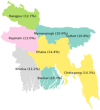Determinants of Modern Contraception Use Among Ever-Married Women in Bangladesh: A Nationwide Cross-Sectional Study
- PMID: 40657295
- PMCID: PMC12247104
- DOI: 10.1002/hsr2.71033
Determinants of Modern Contraception Use Among Ever-Married Women in Bangladesh: A Nationwide Cross-Sectional Study
Abstract
Background and aims: Contraception involves the deliberate prevention of conception through various methods, including mechanical devices, medications, behavioral strategies, or surgical techniques. This study aims to assess the socioeconomic and demographic determinants influencing the adoption of modern contraceptive methods among women.
Methods: A cross-sectional study design was employed, using data from the Bangladesh Demographic and Health Survey (BDHS) 2017-2018. Bivariate analysis was conducted to identify factors associated with contraceptive use, followed by binary logistic regression to evaluate the influence of key socioeconomic and demographic factors.
Results: The study found that ~66.70% of respondents use modern contraceptive methods, predominantly those from urban areas with higher education levels. Conversely, 33.30% of respondents do not use modern contraceptives. Significant determinants of contraceptive use include division, place of residence, education level, husband's education, wealth index, religion, age at first birth, and husband's occupation. Notably, women with higher education are 1.644 times more likely to use modern contraceptives compared to those without education.
Conclusion: Socioeconomic disparities influence contraceptive use, necessitating targeted policies to improve access, particularly in rural and underprivileged communities. Strengthening educational programs and reproductive health services can enhance informed family planning decisions.
Keywords: Bangladesh; contraceptive use; early childbearing; family planning; socioeconomic factors.
© 2025 The Author(s). Health Science Reports published by Wiley Periodicals LLC.
Conflict of interest statement
The authors declare no conflicts of interest.
Figures
Similar articles
-
Inequality in modern contraceptive use and unmet need for contraception among women of reproductive age in Zambia. A trend and decomposition analysis 2007-2018.Reprod Health. 2024 Dec 9;21(1):181. doi: 10.1186/s12978-024-01909-8. Reprod Health. 2024. PMID: 39654062 Free PMC article.
-
Contraceptive use and associated factors among women with HIV receiving care at a faith-based tertiary hospital in Northern Uganda: a cross-sectional study.Ther Adv Reprod Health. 2025 Jul 3;19:26334941251338139. doi: 10.1177/26334941251338139. eCollection 2025 Jan-Dec. Ther Adv Reprod Health. 2025. PMID: 40620280 Free PMC article.
-
Geographic variation in modern contraceptive utilization among women of reproductive age in Mozambique: a multilevel analysis.Contracept Reprod Med. 2024 Dec 30;9(1):68. doi: 10.1186/s40834-024-00332-5. Contracept Reprod Med. 2024. PMID: 39736780 Free PMC article.
-
Behavioral interventions for improving contraceptive use among women living with HIV.Cochrane Database Syst Rev. 2013 Jan 31;(1):CD010243. doi: 10.1002/14651858.CD010243.pub2. Cochrane Database Syst Rev. 2013. Update in: Cochrane Database Syst Rev. 2016 Aug 09;(8):CD010243. doi: 10.1002/14651858.CD010243.pub3. PMID: 23440846 Updated.
-
Brief educational strategies for improving contraception use in young people.Cochrane Database Syst Rev. 2016 Mar 30;3(3):CD012025. doi: 10.1002/14651858.CD012025.pub2. Cochrane Database Syst Rev. 2016. PMID: 27027480 Free PMC article.
References
-
- Lucas A. O., Stoll B. J., and Bale J. R., eds., Reducing Birth Defects: Meeting the Challenge in the Developing World (National Academies Press, 2003). - PubMed
-
- Chowdhury S., Rahman M., Zayed N. M., and Shahi S. K., “Determinants of Age at First Birth of Bangladeshi Women: A Multivariate Approach on DHS 2014 Data,” Journal of Humanities, Arts and Social Science 4, no. 2 (2020): 118–125, 10.26855/jhass.2020.07.006. - DOI
-
- Islam A., Alauddin S., and Barna S., “Socioeconomic and Demographic Predictors of Women's First Birth at an Early Age: Evidence From Bangladesh's Demographic and Health Survey, 2004–2014,” Journal of International Women's Studies 22, no. 1 (2021): 359–373.
LinkOut - more resources
Full Text Sources



